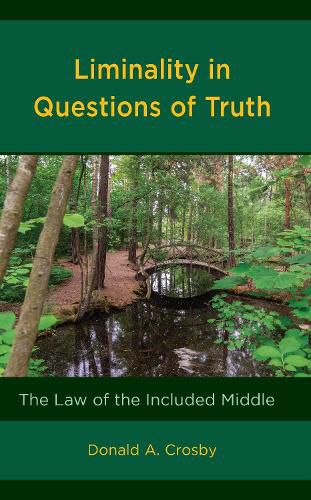Readings Newsletter
Become a Readings Member to make your shopping experience even easier.
Sign in or sign up for free!
You’re not far away from qualifying for FREE standard shipping within Australia
You’ve qualified for FREE standard shipping within Australia
The cart is loading…






A limen links the interior of a building to what lies outside it. It is also the connection between any one of its rooms and other areas of the building. It is thus a kind of necessary included middle marking the transition from one domain to another. We are often tempted to think that the boundary between truth and falsity must always be absolute, and thus that there is no possible bridge between the two; in other words, that it is the nature of any genuine truth to be completely contradicted by its denial. In Liminality in Questions of Truth: The Law of the Included Middle, Donald A. Crosby questions this idea, calling it a Law of the Excluded Middle and contending that, in many cases, there is a Law of the Included Middle that must be carefully considered and thoughtfully applied. Absolute, either/or truths are rare, and most claimed truths, when carefully examined, are imprecise, in need of further investigation, or no longer tenable in their present form. This is especially the case when the alleged truths relate to fundamental, wide-ranging issues of conviction, purpose, and value. Failing to ask the right questions can bar the way to more satisfactory answers. This book argues that searching for liminal bridges between opposing claims is an essential part of such questioning.
$9.00 standard shipping within Australia
FREE standard shipping within Australia for orders over $100.00
Express & International shipping calculated at checkout
A limen links the interior of a building to what lies outside it. It is also the connection between any one of its rooms and other areas of the building. It is thus a kind of necessary included middle marking the transition from one domain to another. We are often tempted to think that the boundary between truth and falsity must always be absolute, and thus that there is no possible bridge between the two; in other words, that it is the nature of any genuine truth to be completely contradicted by its denial. In Liminality in Questions of Truth: The Law of the Included Middle, Donald A. Crosby questions this idea, calling it a Law of the Excluded Middle and contending that, in many cases, there is a Law of the Included Middle that must be carefully considered and thoughtfully applied. Absolute, either/or truths are rare, and most claimed truths, when carefully examined, are imprecise, in need of further investigation, or no longer tenable in their present form. This is especially the case when the alleged truths relate to fundamental, wide-ranging issues of conviction, purpose, and value. Failing to ask the right questions can bar the way to more satisfactory answers. This book argues that searching for liminal bridges between opposing claims is an essential part of such questioning.